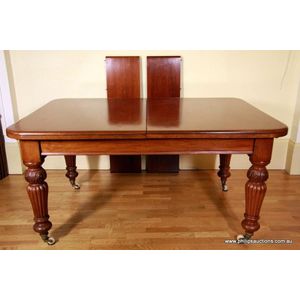Victorian Cedar Dining Table with 3 Leaves
You must be a subscriber, and be logged in to view price and dealer details.
Subscribe Now to view actual auction price for this item
When you subscribe, you have the option of setting the currency in which to display prices to $Au, $US, $NZ or Stg.
- Skirt - In furniture, the skirt is a strip of wood underneath the top or front of the item. On chairs, the skirt is the support under the seat joining the legs, while on tables, the skirt is the support under the top, that assists in supporting the top and also joins the legs. On carcase furniture such as chests and cabinets, the skirt is the timber strip immediately under the drawers or cupboard.
- Baluster (furniture) - An architectural term for a column in a balustrade or staircase, often defined as a "vase shape". The shape is extensively used in furniture and decorative arts.
In furniture, it is used to describe a chair or table leg turned in that form, or more usually as an inverted baluster, with the bulbous section to the top. Less commonly used to describe a chair back that has the outline of a baluster. A baluster may also be split and applied to the front of a cupboard for ornamentation.
For ceramics and silver items it is often used to describe the shape of the whole item, rather than a part.
In Georgian glassware, the shape is commonly seen in the stem of glasses. - Victorian Period - The Victorian period of furniture and decorative arts design covers the reign of Queen Victoria from 1837 to 1901. There was not one dominant style of furniture in the Victorian period. Designers used and modified many historical styles such as Gothic, Tudor, Elizabethan, English Rococo, Neoclassical and others, although use of some styles, such as English Rococo and Gothic tended to dominate the furniture manufacture of the period.
The Victorian period was preceded by the Regency and William IV periods, and followed by the Edwardian period, named for Edward VII (1841 ? 1910) who was King of the United Kingdom and the British Dominions and Emperor of India for the brief period from 1901 until his death in 1910.
This item has been included into following indexes:
- tables, large dining
- tables, material - Australian cedar 105
Visually similar items

A Victorian mahogany extending dining table, 1870s/'80s, the rectangular top (with two spare leaves) with a moulded edge above a plain frieze, raised on turned legs with brass caps and castors. Height 75 cm. Length 238 cm. (extended) width 125 cm

A Victorian cedar extension dining table. second half 19th century, with two extension leaves and winder, the square table with rounded ends above a deep skirt with a reeded trim and supported on four waisted baluster reeded legs with foliate carved caps,

A William IV mahogany extension table, 1830s, with one leaf, having an extended bullnose edged top above a deep skirt and supported on carved and turned legs with knops, centurion skirt decoration and raised on toupie feet with brass casters, height 78 cm,

A William IV cedar extension table, circa 1830s, with three leaves and winder, the table with rounded corners having a thick top above an extended bullnose edge, a deep skirt and raised on relief carved knopped and centurion skirt style baluster legs and t
